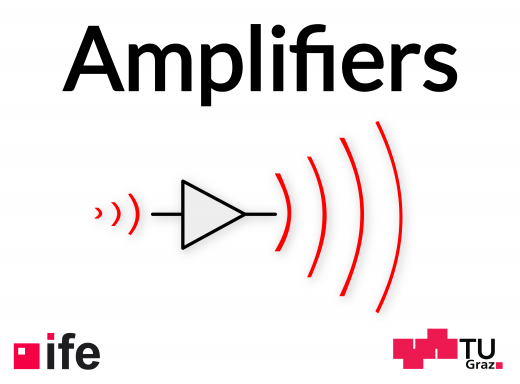
Project Lead:
Michael Fuchs
ElectrONiX MOOC Team:
Dominik Zupan, Patrick Schrey, Nikolaus Czepl
Sabrina Koffler, Clara Scheiber, Thomas Schwar, Christoph Maier
Video Editing and Sound:
Jeremias Hutegger, Daniel Brantner (LLT TU Graz), Stefan Janisch (LLT TU Graz)
Translation:
Ćazim Sinanagić
Electronics is the science of controlling electrical current. Probably the most important control elements available to us in microelectronics are transistors and diodes. They serve as controllable valves with which complex amplifier circuits can be built.
But how do such amplifiers work? How can they be calculated and dimensioned and what properties do such circuits have?
In this MOOC, the basic properties of diodes and different types of transistors, as well as their use in various amplifier circuits are covered. The goal is to provide the mathematical tools as well as the practical understanding to be able to dimension amplifier circuits independently. For this purpose, many calculation, simulation and practical examples are available in order to be able to build a simple audio amplifier at the end of the course, as well as to gain comprehensive knowledge about the function and use of operational amplifiers.
The course is divided into five parts:
-
Fundamental components
- Diodes
- Bipolar transistors
- MOSFETs
- Current sources
- Transistor amplifiers
- Differential amplifiers
- Operational amplifiers
The learning objectives of each section are divided into four learning objective taxonomy levels and are detailed again in the respective sections. For the sake of clarity, only the learning objectives of the highest taxonomy level are listed here.
- Select a suitable diode for a given application and calculate appropriate series resistors.
- Select, calculate and build suitable components for given circuits with MOSFETs and bipolar transistors.
- Select appropriate components for a given circuit of a current source, current mirror, and reference voltage source.
- Develop a voltage amplifier from a current amplifier.
- Design a differential amplifier based on given parameters.
- Select suitable transistors for the design of a differential amplifier based on given parameters with the help of their data sheets.
- Select and size an operational amplifier circuit for a given input and output voltage.
- Develop a way to adjust the offset voltage in a given operational amplifier circuit.
- Using an input and output signal, identify the cause of non-ideal behavior in an operational amplifier circuit.
The MOOC assumes only some basic knowledge of electrical engineering. This includes:
- Ohm's law,
- Kirchhoff's circuit rules,
- Alternating and direct current,
- Basics of electrical components (resistor, coil, capacitor, voltage and current sources).
Each unit is structured as follows:
- The first videos lay the theoretical foundations of each unit.
- These Videos are followed by a voluntary self-examination to check the theoretical knowledge.
- The following block deals with practical examples,
- again followed by a voluntary self-examination.
- For the particularly motivated, we offer additional material. This can be simulation examples or detailed elaborations.
- Finally, there is a test. In order to obtain a certificate, at least 75% of the points must be achieved.
- Positive completion of the test results in receiving a badge.
Questions can be asked in the accompanying forum. These can then be answered by both the course creators and the participants.
For actively participating in the course you will receive an automatic certificate which includes your username, the course name as well as the completed lessons. We want to point out that this certificate merely confirms that the user answered at least 75% of the self-assessment questions correctly.
In addition, a badge is created for each unit, which can be downloaded as an image.
This work is licensed under a {licenselink}. This includes all pictures with the exception of all logos.
This MOOC was funded by the METIS ("MicroElectronics, Training, Industry and Skills") project within the Erasmus+ programme of the European Union. More information about the project is available at https://www.metis4skills.eu/.
Courses
This course can be taken concurrently with the course "Elektronische Schaltungstechnik 1, VO"/"Electronic Circuit Design 1, L" at Graz University of Technology.